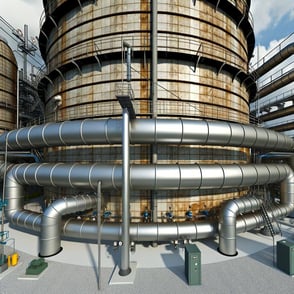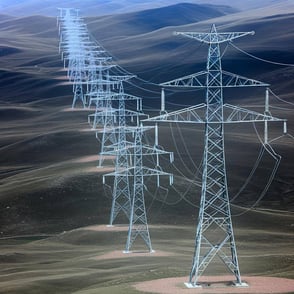Capacitor Energy Storage
Capacitors store energy in an electric field between conductors, offering high power density, rapid charge/discharge, and crucial support for power conditioning and renewables.
What Capacitor Storage Systems?
Capacitor energy storage is a technology that stores electrical energy in an electric field, created by a pair of conductors separated by an insulating material called a dielectric. Capacitors are fundamental components in electronic circuits, known for their ability to charge and discharge rapidly. They are widely used for short-term energy storage and power conditioning in various applications, from consumer electronics to industrial systems. While traditional capacitors are limited in their energy storage capacity, they are essential for their high power density and fast response times. Supercapacitors, a more advanced type of capacitor, offer greater energy storage capabilities.
How Capacitors Work
Capacitors store energy by accumulating electric charge on two conductive plates separated by a dielectric material. When a voltage is applied across the plates, an electric field is established, causing positive charges to accumulate on one plate and negative charges on the other. The amount of energy stored in a capacitor is proportional to the voltage applied and the capacitance, which depends on the surface area of the plates, the distance between them, and the properties of the dielectric material.
The basic process of storing energy in a capacitor involves charging and discharging. When a voltage is applied, electrons are driven onto one plate, creating a negative charge, while electrons are removed from the other plate, creating a positive charge. This process stores energy in the electric field between the plates. When the voltage is removed or the capacitor is connected to a load, the stored energy is released as the electrons flow back to their original positions, providing a burst of electrical power.
There are various types of capacitors, each designed for specific applications based on their characteristics. Electrolytic capacitors have a high capacitance and are commonly used in power supply circuits for smoothing and filtering applications. They use an electrolyte as the dielectric material, allowing for high capacitance in a relatively small package. Ceramic capacitors are known for their stability and reliability. Ceramic capacitors are used in high-frequency applications such as RF circuits and decoupling. They use a ceramic material as the dielectric and are available in various capacitance values and voltage ratings. Film capacitors use a thin plastic film as the dielectric and are known for their excellent performance in high-frequency and high-current applications. They are commonly used in audio, power, and signal processing circuits. Tantalum capacitors offer high capacitance per volume and are used in applications requiring high reliability and stability, such as in military and aerospace electronics. They use tantalum metal as the dielectric.
.png?width=397&height=392&name=Capacitor%20(2).png)
The Impact of Capacitors on the Energy Sector
Capacitors help maintain voltage stability and improve power quality in electrical grids. By filtering out noise and reducing voltage spikes, they protect sensitive electronic equipment and enhance the reliability of power supply systems. They also contribute to energy efficiency by providing rapid energy storage and discharge capabilities. This is particularly important in applications requiring high power density and quick response times, such as in industrial machinery and transportation systems.
Capacitors support the integration of renewable energy sources by smoothing out the intermittent and variable nature of power generation from solar and wind. They help maintain a stable output, reducing the impact of fluctuations on the grid.
Capacitor energy storage systems are environmentally friendly, as they do not involve hazardous materials such as those used by batteries or generate waste. By improving the efficiency and reliability of energy systems, capacitors contribute to reducing greenhouse gas emissions and promoting a cleaner energy future.
Conclusion
Capacitor energy storage is a vital technology in modern electrical and electronic systems. With their ability to store and release energy quickly, capacitors play a crucial role in power conditioning, energy efficiency, and the integration of renewable energy sources. As the demand for reliable and efficient energy storage solutions continues to grow, capacitors will remain an essential component in the transition to a sustainable and resilient energy future.
Glossary
- Capacitor Energy Storage: A technology that stores electrical energy in an electric field created by a pair of conductors separated by a dielectric material.
- Dielectric Material: An insulating material placed between the conductive plates of a capacitor, which increases its capacitance.
- Electrolytic Capacitors: Capacitors that use an electrolyte as the dielectric material, offering high capacitance and commonly used in power supply circuits.
- Ceramic Capacitors: Capacitors that use ceramic material as the dielectric, known for stability and reliability in high-frequency applications.
- Film Capacitors: Capacitors that use a thin plastic film as the dielectric, suitable for high-frequency and high-current applications.
- Tantalum Capacitors: Capacitors that use tantalum metal as the dielectric, known for high reliability and stability in critical applications.
- Supercapacitors: Advanced capacitors that offer greater energy storage capabilities compared to traditional capacitors, covered in a separate article.
- Power Conditioning: The process of stabilizing voltage and power flow in electrical systems to improve power quality.
- Regenerative Braking: A system in electric vehicles that captures and stores energy during braking and releases it during acceleration to improve efficiency.
- Renewable Energy Integration: The process of incorporating renewable energy sources such as solar and wind power into the energy grid.
- Greenhouse Gas Emissions: Gases released into the atmosphere that contribute to the greenhouse effect and global warming, such as carbon dioxide and methane.
.png?width=200&height=80&name=etpa-logo-color%20(1).png)































.png)
.png)
-1.png?width=250&height=100&name=etpa-logo-color%20(1)-1.png)